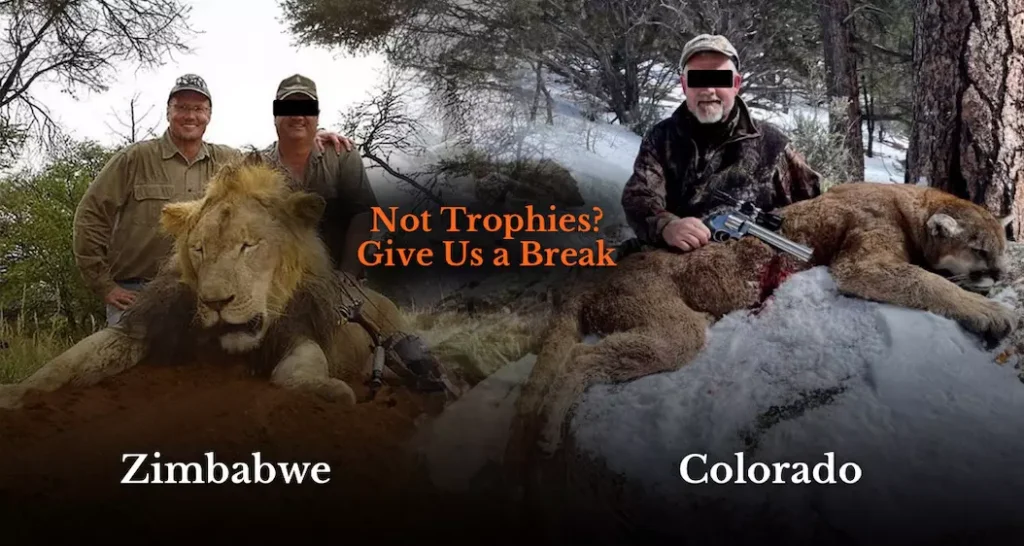
American Mountain Lion Trophy Hunting Enthusiasts Trot Out a Stream of False Information in Prop 127 Fight
The benefits of wild cats in the Colorado landscape and arguments for human-wild cat coexistence without trophy hunting or commercial trapping
- Wayne Pacelle
Ballots will be mailed to 4.5 million Colorado voters today, and citizens can submit completed ballots at any time between now and Nov. 5.
Prop 127 is a major focus for animal welfare advocates and conservationists in the Rocky Mountain State and the nation because it seeks to halt Colorado’s unnecessary and ruthless practices of trophy hunting and commercial fur trapping of mountain lions and bobcats.
This very small segment of 2,000 trophy hunters and 700 fur trappers kills as many as 2,500 lions and bobcats for their heads, hides, and beautiful coats during a four-month assault, rigging the hunt with packs of dogs, bait, cage traps, and high-tech gadgetry. They even use drones.
As is typical in so many ballot issue campaigns, big-money opposition seeks to confuse voters and prompt them to opt for the status quo.
The biggest funder of the “No on 127” campaign is a Virginia-based Concord Fund, which focuses on federal judicial appointments and has no professional staff with any conservation or wildlife experience. The second biggest funder, if you add up donations from its chapters around the country, is Safari Club International, which has an elaborate awards program for its members who amass trophies of dead wildlife. Its best-known award is the “Africa Big Five,” requiring the shooting of an African lion, a leopard, an African elephant, a rhino, and a Cape Buffalo. A lesser-known prize is “Cats of the World,” and North American mountain lions and Canada lynx qualify as trophies for that awards category.
On Prop 127, these special interest groups have offered up a steady stream of misinformation to mislead and confuse voters so they can continue recklessly killing native wild cats. Today, I address false claims to set the record straight.
False Claim: Trophy hunting is already banned in Colorado.
Fact: There is no statute or regulation in the state that says anything about banning trophy hunting. Trophy hunting is perfectly legal in Colorado, and there is a tiny segment of the larger hunting community obsessed with obtaining a nose-to-tail trophy of a lion. Most of the successful trophy hunters shell out $8,000 to a hunting guide, who maintains the dog packs, drones, and GPS equipment, and sets up a point-blank shot at a lion clinging to a tree branch.
Only California bans trophy hunting of lions, and it would have been big news had Colorado forbidden trophy hunting. But no one has even taken note of such a ban, because it doesn’t exist. It is a political fabrication, not a policy truth.
Trophy hunting of lions — in Africa and in the Americas — has been going on since the 19th century. Lion hunting is now banned in the vast majority of South American countries, and it’s tougher for Americans to hunt African and Asiatic lions overseas because the species are classed as threatened or endangered across their ranges. That means that a major reservoir of potential cat trophies exists in North America, and there are trophy hunting vendors who caters to this subculture and deliver the point-blank shot and then the trophy for mounting and display
Indeed, it’s not hard to find promotions of “trophy hunting” by the network of professional hunting guides who offer “guaranteed kills” of trophy “toms” to their fee-paying clients, such as this one from Huntin’ Fool. The term “trophy” is ubiquitous among the non-purged sites whose owners charge wealthy hunters $8,000 or more to kill a lion in Colorado.
On the internet, and specifically on the websites of hunting guides, it’s plain as day that the purpose of the hunt is to secure a trophy: “We start our days very early driving roads looking for mountain lion tracks,” according to one guide on BookYourHunt. “Once we have a track located, we release hounds and catch your cat. Using GPS technology we track the hounds and precisely locate where they treed your trophy. We then determine the easiest route to take you into your trophy.” A different guide says cost depends on “the outfitter’s reputation for producing quality trophies.” A posting online by one lion-hunting guide talks of strapping a dead lion to a horse, with the caption “tying on the trophy.”
The animal welfare community didn’t invent the notion of “trophy hunting.” The trophy hunters coined it, and today’s trophy hunters are part of that tradition of wildlife exploitation. We draw the phrase directly from their literature, their promotional materials, and the celebrations.
And how would the taxidermy industry operate at all if not for trophy hunters?
False Claim: Packs of dogs are needed to allow for sex selection of male lions, so they don’t shoot the females.
Fact: If it’s their game plan to reduce the number of females killed by eyeing the cat cornered in a tree, I can assure you it’s not working. During the 2023-24 lion-hunting season, 47% of the 501 lions shot by trophy hunters were females.
Many of the females shot from a tree had dependent young tucked away in a den or roaming on their own. The shooting of those females dooms the family group. Lions can breed at any time of the year, so there is no safe season for avoiding orphaning.
The truth is, dog packs are used to rig the hunt. Mountain lion guides just arrested in Utah and Idaho all used dogs in their orchestrating of commercial kills of lions. The trophy hunts happen just about the same way in all these states. Same guides, slightly different settings.
Dogs are not allowed for any other so-called big game — not for deer, elk, or bears. Just for lions and bobcats.
False claim: Wildlife experts decide wildlife policy in Colorado.
Fact: It was the state Legislature that authorized mountain lion hunting in Colorado, and it’s the Colorado Wildlife Commission, a policymaking body appointed by seated governors, that approves annual hunting regulations that allow the use of dogs and high-tech gadgetry for lion hunting. These elected and appointed individuals are also the people who allow baiting of bobcat traps and the use of nooses and clubs to kill bobcats for their fur.
There are no requirements for either appointed wildlife commissioners or state lawmakers to have undergraduate or graduate degrees in any discipline of wildlife science or ecology. But even if they did — and precious few of these decision-makers do — it doesn’t mean that they have a monopoly on truth. Matters of trophy hunting and hunting methods are matters of values, ethics, and science. There are MDs, DVMs, and PhDs on both sides of just about every policy issue in America — from medical and veterinary research to health policy to criminal justice reform to agriculture policy. To cite the clearest example in our history of scientists getting it wrong, look at how the smoking industry trotted out experts and bamboozled policy makers for years and told the public that smoking posed no major health risks.
When representative government and political appointees at state commissions fail to do their jobs, then the citizens can opt to put a ballot question to the voters, given that the Colorado Constitution allows for a direct democracy.
There have been only two instances in Colorado history when citizen initiatives secured enough signatures to place measures on the statewide ballot to promote more humane and more responsible policies related to wildlife protection: 1) bear hunting, and 2) trapping.
By a lopsided vote of more than two to one, voters in 1992 banned spring hunting of bears and any bear baiting and hounding. It was the Colorado Wildlife Commission and Colorado state wildlife agency that allowed those atrocious hunting methods to be conducted for years until voters swatted them away as cruel and unsporting.
And four years later, voters also stopped the use of cruel and indiscriminate steel-jawed leghold traps and neck and body snares to kill animals for their fur and for recreation. And, yes, that’s because the Wildlife Commission and the state wildlife agency allowed those landmines for wildlife.
Citizens have always served as a check on reckless decision-making by state legislators and government agencies. In the case of wildlife policy, the process of creating humane treatment standards for wildlife by ballot initiative has been extraordinarily sparing. In every case, voters have adopted to stop inhumane, unfair, and commercial exploitation of wildlife, and there have been no serious attempts to revisit these policies.
False Claim: Mountain lion trophy hunting is “science-based” wildlife management.
Fact: There is no research or scientific evidence to support the idea that trophy killing of lions achieves any valuable social or management purpose, whether to keep populations in check or to reduce occasional conflicts. Twenty-two wildlife scientists, many of them with field experience with lions, affirmed that notion in an open letter to Colorado voters. “Wild cats evolved in Colorado’s natural ecosystems and maintain stable populations,” reported the scientists.
Science is not an opinion, but an aggregation of information, often published in peer-reviewed journals, used to inform policy judgments. It is not an end in itself, but a means of evaluation. Good science gives us options, not answers.
Among the signatories was Dr. Rob Wielgus, former director of the Carnivore Conservation Lab of Washington State University. Dr. Wielgus did pioneering work to demonstrate that trophy hunting creates social chaos among surviving lions, with fellow scientists noting in their joint letter that “trophy hunting may also exacerbate human-lion conflicts by removing unoffending animals from the ecosystem, leaving the door open to younger cats who are more likely to be involved in conflict random recreational killing of lions.”
“These wild cat populations can and do regulate themselves, while providing a multitude of benefits to ecosystems,” commented Dr. Elaine Leslie, PhD, former chief of biological services for the National Park Service, who concluded that “the inhumane trapping and hunting of mountain lions and bobcats is not an ethical management tool.”
In addition to them, Dan Ashe has also weighed in and urged voters to approve Prop 127. Ashe was the top wildlife management official in the United States for years, with his role as director of the U.S. Fish and Wildlife Service from 2010-2016. He says trophy hunting of lions is wrong. He particularly underscores that using dogs and GPS gadgetry makes it unsporting, with the culmination of the hunt the shooting of a terrified animal in a tree.
It is an axiom of American politics that there is a bilge pump of misleading, false information washing over the public during election season. There’s no better example of this social science phenomenon than the “No on Prop 127” campaign.

